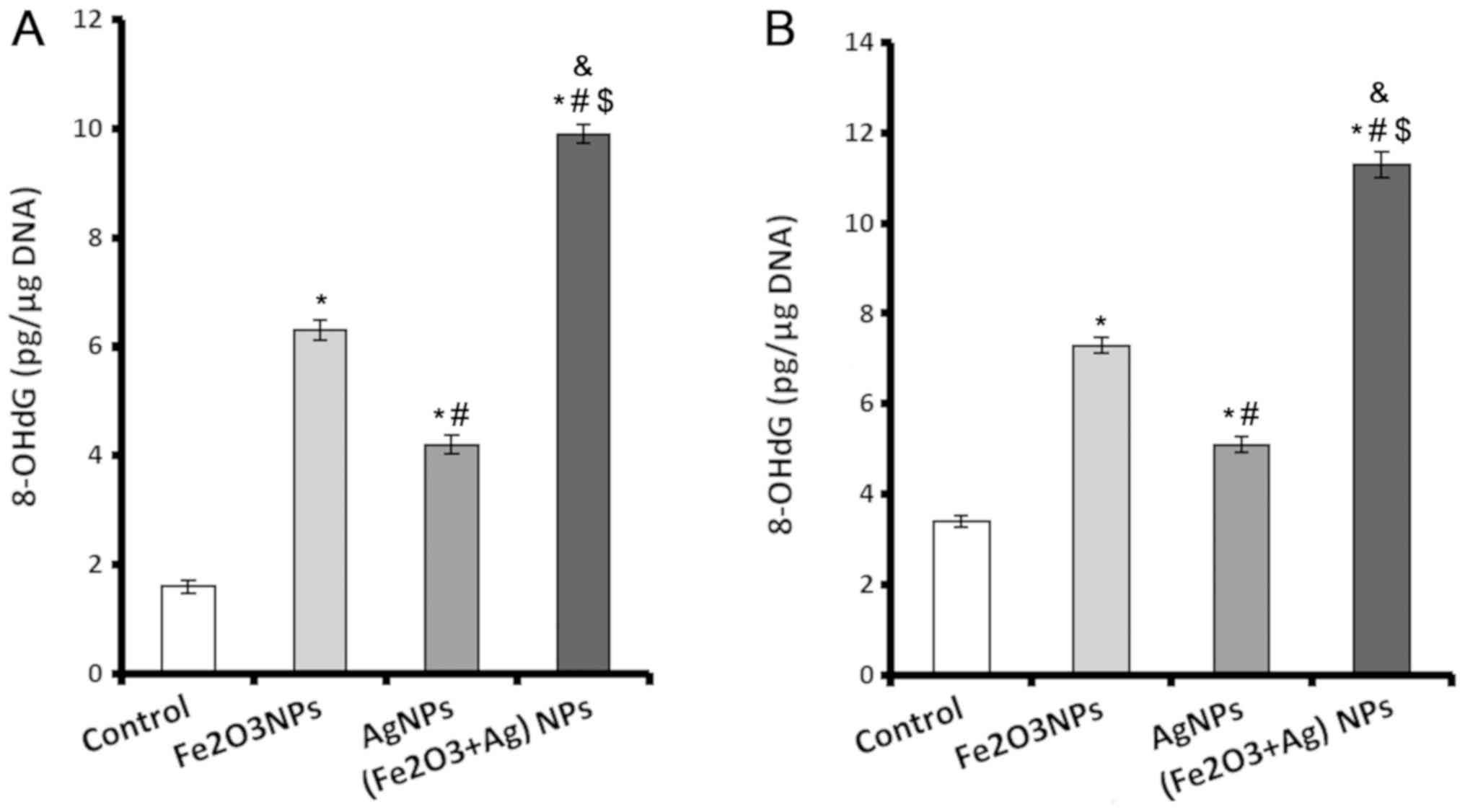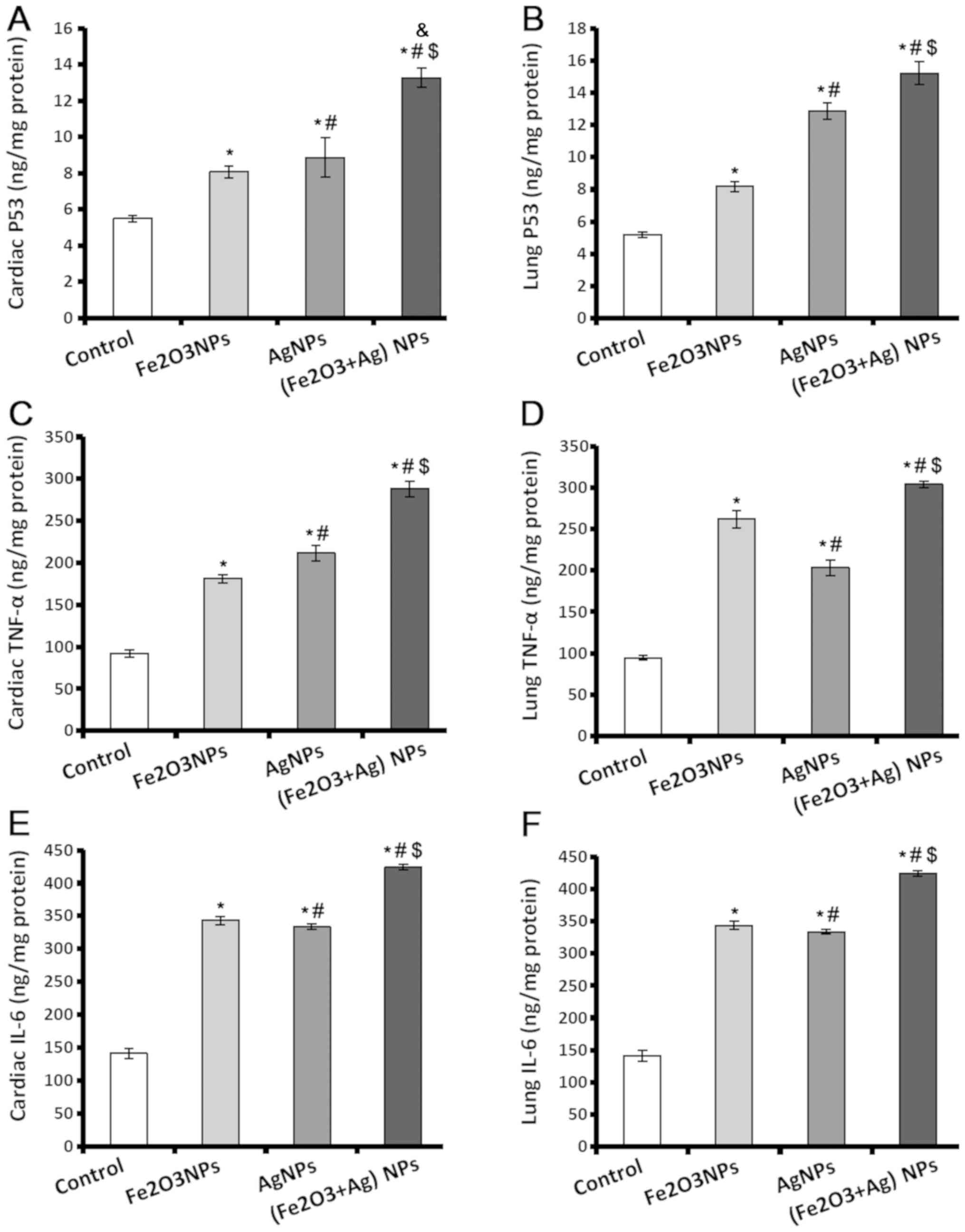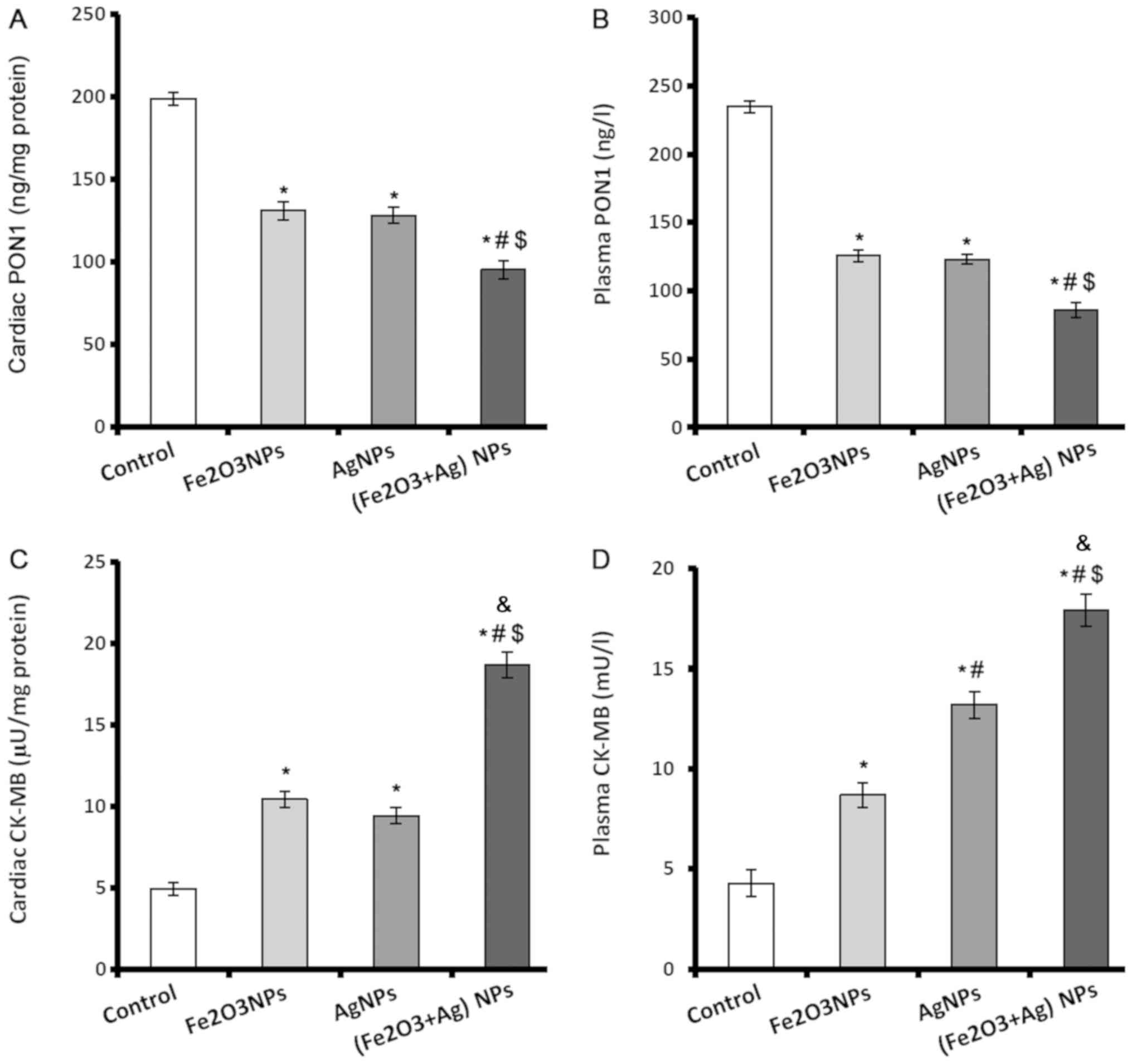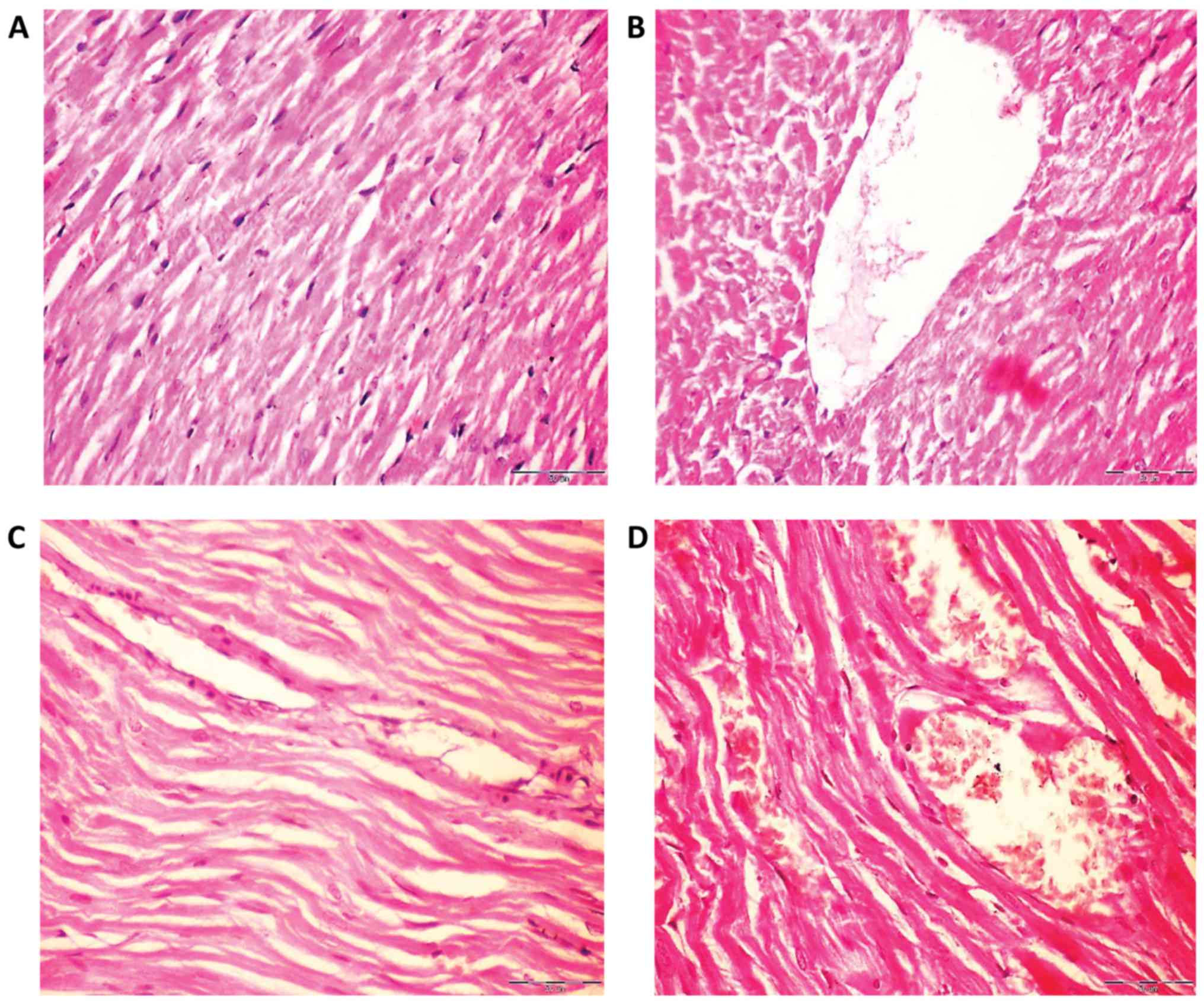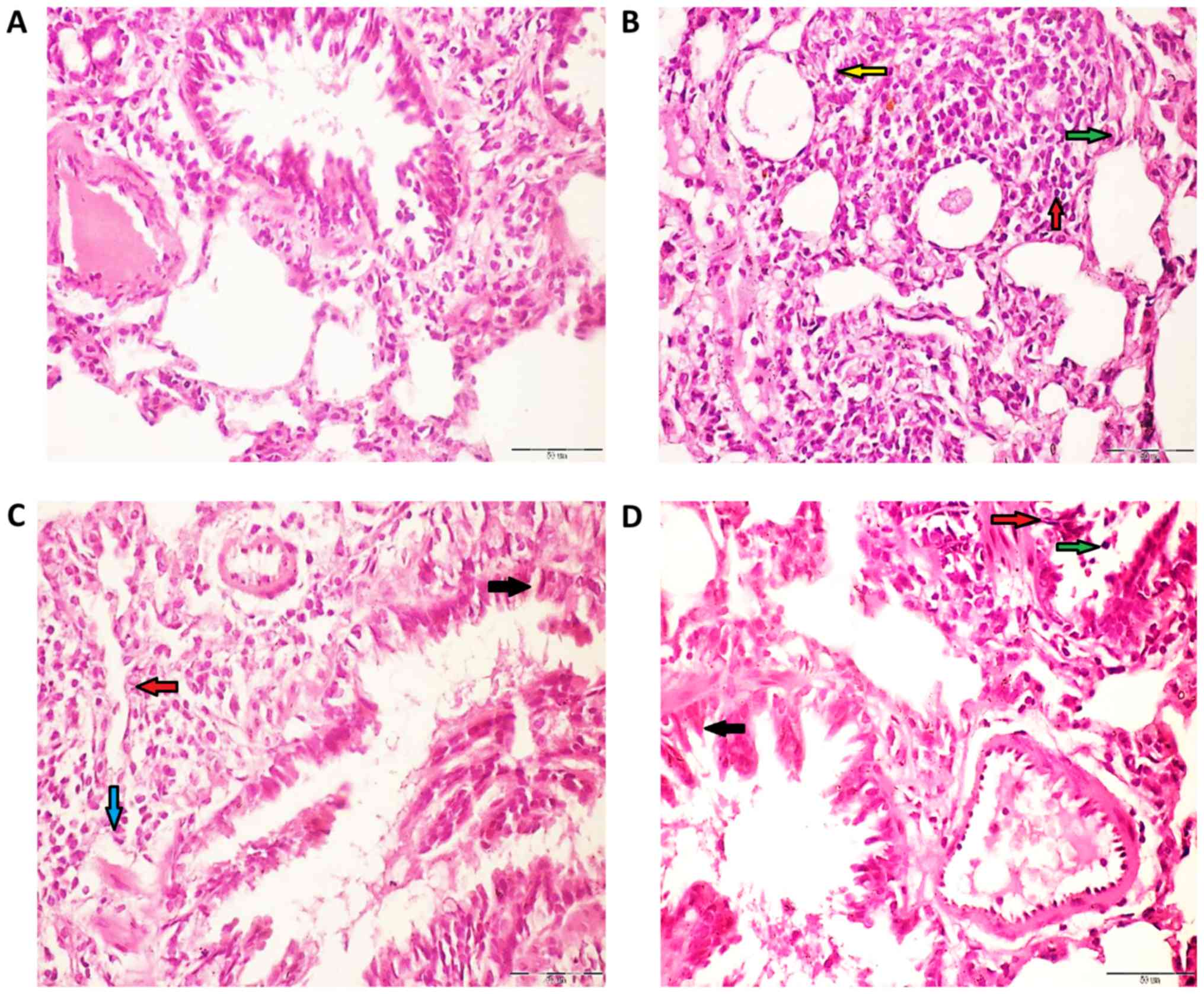|
1
|
Oberdörster G, Stone V and Donaldson K:
Toxicology of nanoparticles: A historical perspective.
Nanotoxicology. 1:2–25. 2007. View Article : Google Scholar
|
|
2
|
Karlsson HL, Gustafsson J, Cronholm P and
Möller L: Size-dependent toxicity of metal oxide particles-a
comparison between nano-and micrometer size. Toxicol Lett.
188:112–118. 2009. View Article : Google Scholar : PubMed/NCBI
|
|
3
|
Senapati S, Ahmad A, Khan MI, Sastry M and
Kumar R: Extracellular biosynthesis of bimetallic AuAg alloy
nanoparticles. Small. 1:517–520. 2005. View Article : Google Scholar : PubMed/NCBI
|
|
4
|
Khan I, Saeed K and Khan I: Nanoparticles:
Properties, applications and toxicities. Arab J Chem. MAy
18–2017.(Epub ahead of print). doi: 10.1016/j.arabjc.2017.05.011.
View Article : Google Scholar
|
|
5
|
Akter M, Sikder T, Rahmana M, Ullah A,
Hossain KFB, Banik S, Hosokawa T, Saito T and Kurasaki M: A
systematic review on silver nanoparticles-induced cytotoxicity:
Physicochemical properties and perspectives. J Adv Res. 9:1–16.
2018. View Article : Google Scholar : PubMed/NCBI
|
|
6
|
Zhu MT, Wang B, Wang Y, Yuan L, Wang HJ,
Wang M, Ouyang H, Chai ZF, Feng WY and Zhao YL: Endothelial
dysfunction and inflammation induced by iron oxide nanoparticle
exposure: Risk factors for early atherosclerosis. Toxicol Lett.
203:162–171. 2011. View Article : Google Scholar : PubMed/NCBI
|
|
7
|
Liu J and Hurt RH: Ion release kinetics
and particle persistence in aqueous nano-silver colloids. Environ
Sci Technol. 44:2169–2175. 2010. View Article : Google Scholar : PubMed/NCBI
|
|
8
|
Bar-Ilan O, Albrecht RM, Fako VE and
Furgeson DY: Toxicity assessments of multisized gold and silver
nanoparticles in zebrafish embryos. Small. 5:1897–1910. 2009.
View Article : Google Scholar : PubMed/NCBI
|
|
9
|
Szalay B, Tátrai E, Nyírő G, Vezér T and
Dura G: Potential toxic effects of iron oxide nanoparticles in vivo
and in vitro experiments. J Appl Toxicol. 32:446–453. 2012.
View Article : Google Scholar : PubMed/NCBI
|
|
10
|
Sharma VK, Yngard RA and Lin Y: Silver
nanoparticles: Green synthesis and their antimicrobial activities.
Adv Colloid Interface Sci. 145:83–96. 2009. View Article : Google Scholar : PubMed/NCBI
|
|
11
|
The University of Iowa. Office of animal
resources, . Institutional animal care and use committee. IACUC
Guidelines: Anesthesia. https://animal.research.uiowa.edu/iacuc-guidelines-anesthesiaDecember
26–2018
|
|
12
|
Draper HH and Hadley M: Malondialdehyde
determination as index of lipid peroxidation. Methods Enzymol.
186:421–431. 1990. View Article : Google Scholar : PubMed/NCBI
|
|
13
|
Guevara I, Iwanejko J, Dembińska-Kieć A,
Pankiewicz J, Wanat A, Anna P, Gołabek I, Bartuś S,
Malczewska-Malec M and Szczudlik A: Determination of
nitrite/nitrate in human biological material by the simple Griess
reaction. Clin Chim Acta. 274:177–188. 1998. View Article : Google Scholar : PubMed/NCBI
|
|
14
|
Griffith OW: Determination of glutathione
and glutathione disulfide using glutathione reductase and
2-vinylpyridine. Anal Biochem. 106:207–212. 1980. View Article : Google Scholar : PubMed/NCBI
|
|
15
|
Mueller RF, Hornung S, Furlong CE,
Anderson J, Giblett ER and Motulsky AG: Plasma paraoxonase
polymorphism: A new enzyme assay, population, family, biochemical,
and linkage studies. Am J Hum Genet. 35:393–408. 1983.PubMed/NCBI
|
|
16
|
Drury RA and Wallington EA: Carleton's
Histological Techniques6th. Oxford University Press; New York, NY,
Toronto: 1980
|
|
17
|
Fumagalli M, Rossiello F, Clerici M,
Barozzi S, Cittaro D, Kaplunov JM, Bucci G, Dobreva M, Matti V,
Beausejour CM, et al: Telomeric DNA damage is irreparable and
causes persistent DNA-damage response activation. Nat Cell Biol.
14:355–365. 2012. View Article : Google Scholar : PubMed/NCBI
|
|
18
|
Asharani PV, Hande MP and Valiyaveettil S:
Anti-proliferative activity of silver nanoparticles. BMC Cell Biol.
10:652009. View Article : Google Scholar : PubMed/NCBI
|
|
19
|
Singh RP and Ramarao P: Cellular uptake,
intracellular trafficking and cytotoxicity of silver nanoparticles.
Toxicol Lett. 213:249–259. 2012. View Article : Google Scholar : PubMed/NCBI
|
|
20
|
Foldbjerg R, Olesen P, Hougaard M, Dang
DA, Hoffmann HJ and Autrup H: PVP-coated silver nanoparticles and
silver ions induce reactive oxygen species, apoptosis and necrosis
in THP-1 monocytes. Toxicol Lett. 190:156–162. 2009. View Article : Google Scholar : PubMed/NCBI
|
|
21
|
Kim SH, Ko JW, Koh SK, Lee IC, Son JM,
Moon C, Kim SH, Shin DH and Kim JC: Silver nanoparticles induce
apoptotic cell death in cultured cerebral cortical neurons. Mol
Cell Toxicol. 10:173–179. 2014. View Article : Google Scholar
|
|
22
|
Patil US, Adireddy S, Jaiswal A, Mandava
S, Lee BR and Chrisey DB: In vitro/in vivo toxicity evaluation and
quantification of iron oxide nanoparticles. Int J Mol Sci.
16:24417–24450. 2015. View Article : Google Scholar : PubMed/NCBI
|
|
23
|
Voinov MA, Sosa Pagán JO, Morrison E,
Smirnova TI and Smirnov AI: Surface-mediated production of hydroxyl
radicals as a mechanism of iron oxide nanoparticle biotoxicity. J
Am Chem Soc. 133:35–41. 2010. View Article : Google Scholar : PubMed/NCBI
|
|
24
|
Lee JH, Ju JE, Kim BI, Pak PJ, Choi EK,
Lee HS and Chung N: Rod-shaped iron oxide nanoparticles are more
toxic than sphere-shaped nanoparticles to murine macrophage cells.
Environ Toxicol Chem. 33:2759–2766. 2014. View Article : Google Scholar : PubMed/NCBI
|
|
25
|
Alarifi S, Ali D and Alkahtani S:
Nanoalumina induces apoptosis by impairing antioxidant enzyme
systems in human hepatocarcinoma cells. Int J Nanomedicine.
10:3751–3760. 2015.PubMed/NCBI
|
|
26
|
Park EJ and Park K: Oxidative stress and
pro-inflammatory responses induced by silica nanoparticles in vivo
and in vitro. Toxicol Lett. 184:18–25. 2009. View Article : Google Scholar : PubMed/NCBI
|
|
27
|
Pujalté I, Passagne I, Brouillaud B,
Tréguer M, Durand E, Ohayon-Courtès C and L'Azou B: Cytotoxicity
and oxidative stress induced by different metallic nanoparticles on
human kidney cells. Part Fibre Toxicol. 8:102011. View Article : Google Scholar : PubMed/NCBI
|
|
28
|
Mukaetova-Ladinska EB, Garcia-Siera F,
Hurt J, Gertz HJ, Xuereb JH, Hills R, Brayne C, Huppert FA, Paykel
ES, McGee M, et al: Staging of cytoskeletal and beta-amyloid
changes in human isocortex reveals biphasic synaptic protein
response during progression of Alzheimer's disease. Am J Pathol.
157:623–636. 2000. View Article : Google Scholar : PubMed/NCBI
|
|
29
|
Nel A, Xia T, Mädler L and Li N: Toxic
potential of materials at the nanolevel. Science. 311:622–627.
2006. View Article : Google Scholar : PubMed/NCBI
|
|
30
|
Wang A, Pu K, Dong B, Liu Y, Zhang L,
Zhang Z, Duan W and Zhu Y: Role of surface charge and oxidative
stress in cytotoxicity and genotoxicity of graphene oxide towards
human lung fibroblast cells. J Appl Toxicol. 33:1156–1164. 2013.
View Article : Google Scholar : PubMed/NCBI
|
|
31
|
McShan D, Ray PC1 and Yu H: Molecular
toxicity mechanism of nanosilver. J Food Drug Anal. 22:116–127.
2014. View Article : Google Scholar : PubMed/NCBI
|
|
32
|
Litvinov D, Mahini H and Garelnabi M:
Antioxidant and anti-inflammatory role of paraoxonase 1:
Implication in arteriosclerosis diseases. N Am J Med Sci.
4:523–532. 2012. View Article : Google Scholar : PubMed/NCBI
|
|
33
|
Nemmar A, Beegam S, Yuvaraju P, Yasin J,
Tariq S, Attoub S and Ali BH: Ultrasmall superparamagnetic iron
oxide nanoparticles acutely promote thrombosis and cardiac
oxidative stress and DNA damage in mice. Part Fibre Toxicol.
13:222016. View Article : Google Scholar : PubMed/NCBI
|
|
34
|
Shen Y, Huang Z, Liu X, Qian J, Xu J, Yang
X, Sun A and Ge J: Iron-induced myocardial injury: An alarming side
effect of superparamagnetic iron oxide nanoparticles. J Cell Mol
Med. 19:2032–2035. 2015. View Article : Google Scholar : PubMed/NCBI
|
|
35
|
Rathore M, Mohanty IR, Maheswari U, Dayal
N, Suman R and Joshi DS: Comparative in vivo assessment of the
subacute toxicity of gold and silver nanoparticles. J Nanopart Res.
16:23382014. View Article : Google Scholar
|
|
36
|
Adeyemi OS and Faniyan TO: Antioxidant
status of rats administered silver nanoparticles orally. J Taibah
Univ Med Sci. 9:182–186. 2014.
|
|
37
|
Warheit DB, Sayes CM, Reed KL and Swain
KA: Health effects related to nanoparticle exposures:
Environmental, health and safety considerations for assessing
hazards and risks. Pharmacol Ther. 120:35–42. 2008. View Article : Google Scholar : PubMed/NCBI
|















